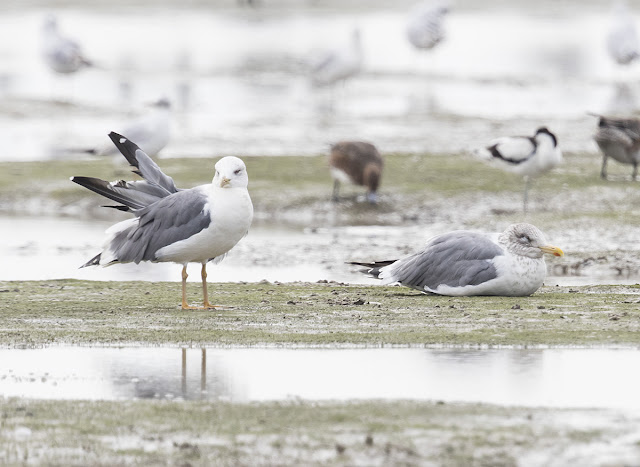An American Wigeon had been around Mai Po board walk for quite some time, I have not had the time to visit this very lost vagrant. This is our second American species this winter (Franklin's Gull being the first) that had wandered far from it's natural range. This species should be wintering somewhere in Southern United States or as far south as Central America, but somehow this one had found it's way to Hong Kong.
American Wigeon - Howdy partner! You could have wintered in Texas.
My Father and I arrived at Mai Po just around 12:30pm. The tide was predicted to be highest at 2:30pm at 1.9m, so that gave us plenty of time. Things started off OK, I got 3 very distant Buff-bellied Pipit upon walking to the AFCD warden's post. At the warden's post a flock of Silky Starlings were close-by. After that, it was all walking. We went directly to the furthest floating bird hide.
Buff-bellied Pipit - a little too far away...
Silky Starling
Upon arrival, we found the bird hide already packed with people! Luckily there was still a space in the corner left for us, so we settled in and started searching. Common birds to start with...Regular Eurasian Wigeons, Shovelers, Pintails, Teals...etc, then there were Curlews, Redshanks, Greenshanks, Pacific Golden Plovers, Temmink's Stints...Black-headed Gulls were everywhere and a few Saunder's Gulls. A single injured Bar-tailed Godwit foraged around, one of it's feet looked strange. Quite a few Common Snipes were hiding in the grass near the bird hide. An Osprey perched on it's favourite spot, a very usual site for Deep Bay. A Black-faced Spoonbill came to about 5 meters to our bird hide, which gave me an opportunity to take some closeup portraits. Great Cormorants were everywhere...
Eurasian Wigeon
Eurasian Curlew
Mixed bag of Pacific Golden Plover, Redshanks and Marsh Sandpiper in the back.
Pacific Golden Plover
Temmink's Stint
Saunder's Gull and Black-headed Gull
Greenshank with Bar-tailed Godwit
Common Snipe
Osprey
Black-faced Spoonbill - extreme closeup
Great Cormorant
Suddenly, there was a huge commotion of birds and everything scattered! Surely enough, an Eastern Marsh Harrier flew past, looking for it's next meal. This is always a spectacle to witness.
All panic!
Eastern Marsh Harrier
After the birds had settled, Michelle Wong spotted the American Wigeon in the flock. I soon locked the telescope onto the bird base on her descriptions. It was moving fast with the other ducks, and I couldn't even come around to show my Dad and I lost it in the huge flock of Eurasian Wigeons. It was out of sight for some time, until another raptor flushed the whole flock of ducks back to the right. I scanned the water once again, and this time relocated the dabbler shortly. This time it was in view long enough for everyone to enjoy! It look so different when you can compare it to Eurasian Wigeons side by side, it looks a little chunkier as well with a bigger head. Great to finally connecting with this rare dabbler, another new tick for me!
American Wigeon - what we came here for today
After we were all satisfied with our American vagrant, we started concentrating on the gulls...None of the rarer wintering gulls were in sight, and no sign of the Franklin's Gull either. So, I settled in to study on the larger gulls presented before me. Three species of large Larus winters in Hong Kong, Heuglin's Gull, Caspian Gull (mongolicus)and Vega Gull. Identification of large gulls in Hong Kong was highly debated many years ago, but it seems the experts had finally settled with these three as our "basic" Herring Gull type species now. Heuglin's are by far our most common of the three, it also got the darkest mantle of the trio. So, it make sense for us to look for birds with lighter mantles, I found one of them that looked promising as a Caspian Gull mongolicus, although it's leg is still quite yellowish instead of the pinkish, but the larger size, cleaner head patterns and lighter mantle make me lean towards it being one? I later saw one inflight with more obvious pinkish legs that I am calling as mongolicus as well...Vega Gull is a little easier, they have the most "dirty" heads, and pinkish legs are also a good indicator. It's the least common of the trio, so it was nice to get a good look. At one point it was approached by a Heuglin's with broken wings while it was sleeping.
Heuglin's Gull - our "baseline"
Caspian Gull (mongolicus) - please do point me out if I am wrong!
Vega Gull
Just as we were packing our things, a White-breasted Kingfisher came and perched on one of the "kingfishers post", a classic pose to end the day!
White-breasted Kingfisher - lovely note to end the day




























No comments:
Post a Comment